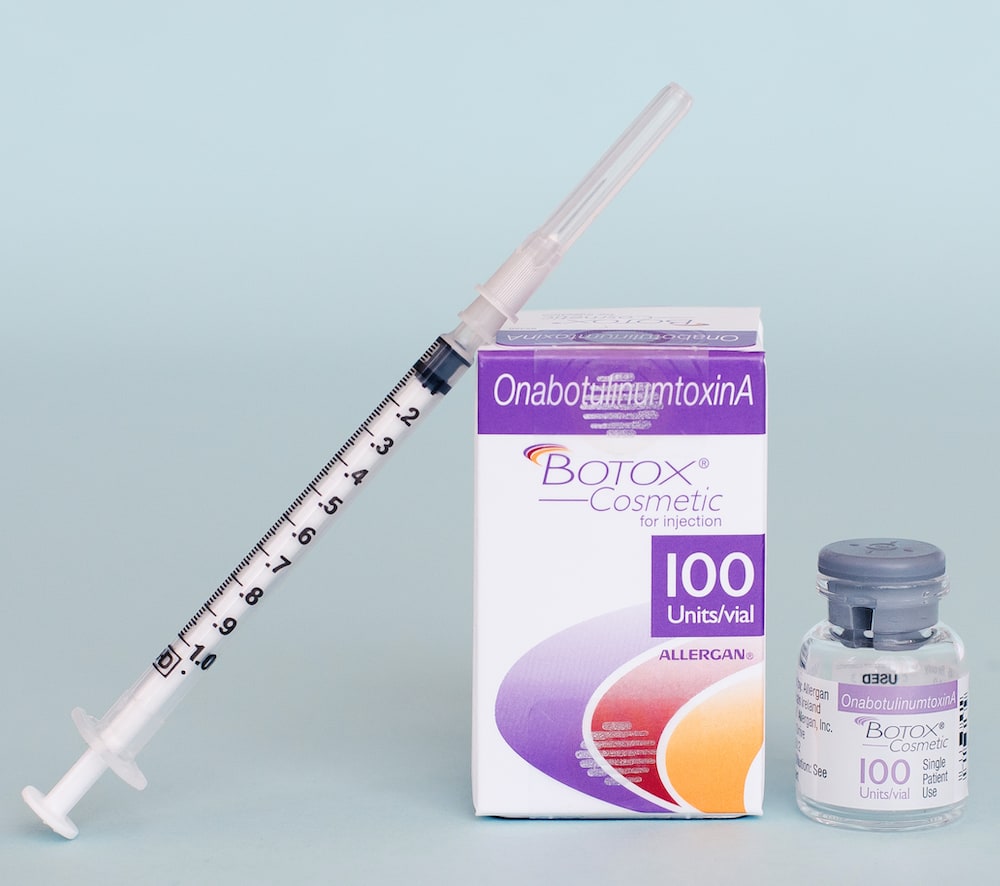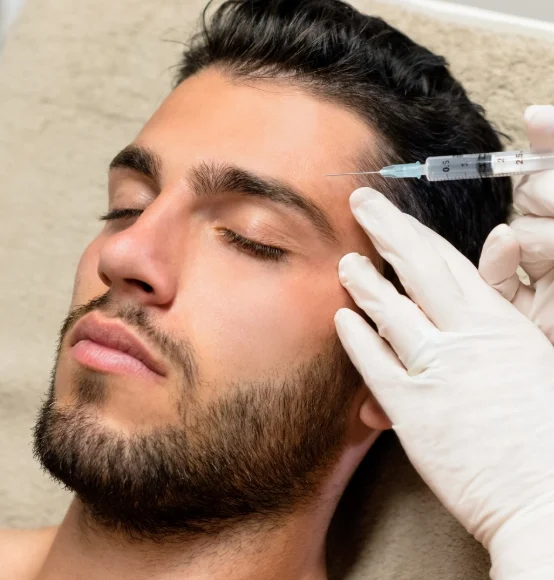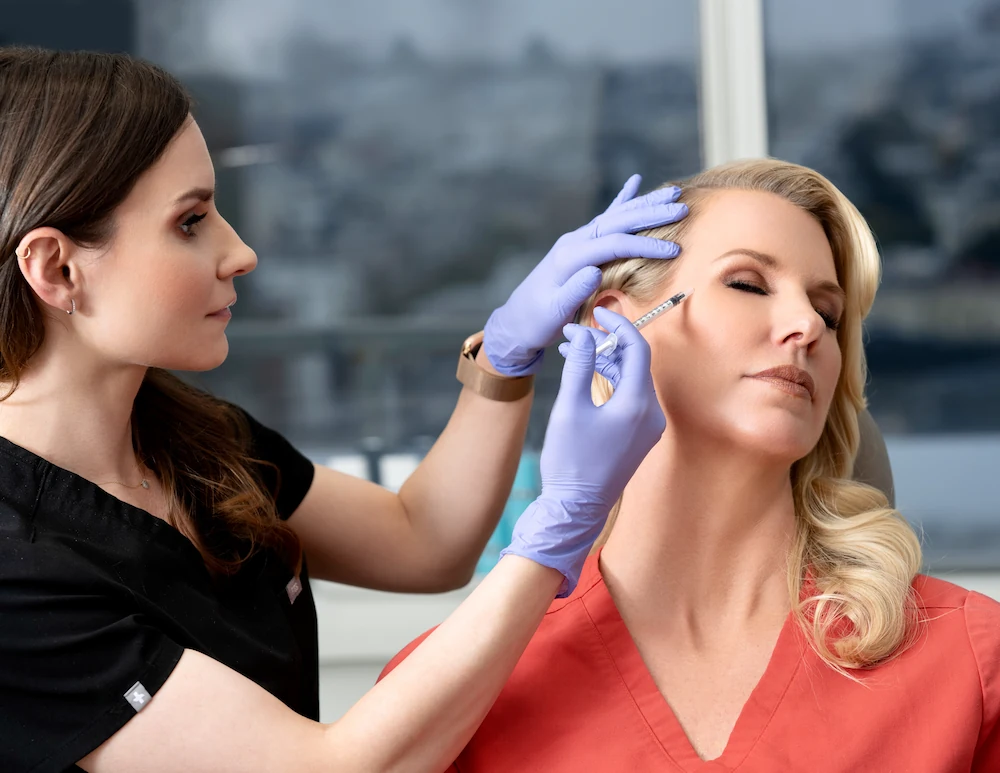Dr. Karen Horton has either authored or reviewed and approved this content.
Page Updated:
Facial lines and wrinkles arise from various factors including aging, genetics, lifestyle, sun exposure, and repeated facial expressions. When we express emotions, the underlying facial muscles contract, causing the skin to move along with them. Over time, frequent contractions can lead to persistent wrinkles that remain even when the face is at rest, often forming the first signs of aging in an otherwise youthful appearance. With continuous muscle activity, the skin may eventually form permanent creases that persist even in a relaxed state. Nurse Practitioner Emily Sespaniak is proud to offer expert Botox injections and other injectable wrinkle reducer treatments (neuromodulator injection) for patients looking to smooth fine lines and wrinkles in .
Botox Cosmetic is an FDA-approved prescription injectable medicine that can smooth moderate to severe lines and wrinkles on the face.1 With visible results within just days and no recovery time, this minimally invasive injectable treatment is ideal for those looking for a quick and easy anti-aging treatment. Botox is so effective that it’s one of the most common and popular cosmetic procedures in the history of Plastic Surgery!
Botox and its alternatives (such as Dysport®) are known as neuromodulators. They work by relaxing muscles temporarily to prevent them from contracting, resulting in smoother and younger looking skin that typically lasts between 3 and 4 months. Botox is indicated for the frown lines between the eyebrows, known as the “glabella”, as well as the horizontal lines on the forehead and the “crow’s feet” around the eyes. Botox can also be administered safely to other facial and body areas, though such uses are considered “off-label.” Some of these areas that are frequently treated “off-label” include the “bunny lines” around the nose, the platysmal bands in the neck, and the downturned corners of the mouth. It can even be used to soften a square-shaped jawline!

 Botox works by temporarily blocking nerve signals to muscles, preventing them from contracting, which smooths out wrinkles and prevents the formation of new ones. The active ingredient in Botox, botulinum toxin type A, is a purified neurotoxin that, when injected in small, controlled doses into specific facial muscles, relaxes them and reduces the appearance of lines and wrinkles. This effect typically lasts about three to four months, after which the muscles gradually regain movement, and the wrinkles may reappear, necessitating further treatment to maintain results.
Botox works by temporarily blocking nerve signals to muscles, preventing them from contracting, which smooths out wrinkles and prevents the formation of new ones. The active ingredient in Botox, botulinum toxin type A, is a purified neurotoxin that, when injected in small, controlled doses into specific facial muscles, relaxes them and reduces the appearance of lines and wrinkles. This effect typically lasts about three to four months, after which the muscles gradually regain movement, and the wrinkles may reappear, necessitating further treatment to maintain results.
Botox offers several aesthetic and therapeutic benefits (and we specialize in both):
These benefits make Botox a versatile and popular choice for those looking to manage the signs of aging or treat specific medical issues.
To prepare for a Botox treatment, schedule a consultation to discuss your goals and medical history, and avoid blood-thinning medications, herbal supplements, and alcohol for one week prior to treatment to minimize bruising. On the day of your appointment, arrive with clean skin, free of makeup or irritating skin care products. Inform our Nurse Practitioner Emily Sespaniak about any previous Botox injections and relevant health conditions.

 Injection of Botox takes approximately 15 minutes and any discomfort is usually minimal and brief. We have every patient apply a cold compress to the treatment sites prior to injection to minimize discomfort. Possible temporary side effects associated with the injection include localized pain, inflammation, tenderness, swelling, redness, bleeding, or bruising. Most people will notice that Botox starts to work in about a week, while Dysport tends to produce results even sooner (two to three days on average). We recommend that all our patients return to our office two weeks after their first treatment for a “perfection check” to ensure you are pleased with the results and to make adjustments as needed. The results will continue to improve over the next 30 days and should last between 3-4 months for most people (results may vary).
Injection of Botox takes approximately 15 minutes and any discomfort is usually minimal and brief. We have every patient apply a cold compress to the treatment sites prior to injection to minimize discomfort. Possible temporary side effects associated with the injection include localized pain, inflammation, tenderness, swelling, redness, bleeding, or bruising. Most people will notice that Botox starts to work in about a week, while Dysport tends to produce results even sooner (two to three days on average). We recommend that all our patients return to our office two weeks after their first treatment for a “perfection check” to ensure you are pleased with the results and to make adjustments as needed. The results will continue to improve over the next 30 days and should last between 3-4 months for most people (results may vary).
Our practice utilizes a conservative approach to Botox treatment that prioritizes preserving natural facial movement while relaxing the muscles enough to treat and prevent lines and wrinkles. Despite popular myth, you do not need to be “frozen” to reap the benefits of Botox!

After a Botox treatment, it’s important to follow specific aftercare instructions to maximize the effectiveness of the procedure and minimize side effects. Avoid touching or massaging the treated areas for 24 hours to prevent the toxin from spreading to unintended muscles. We recommend you refrain from strenuous activities for the remainder of the day and avoid lying down flat for 4 hours post-treatment. Minimal side effects like mild bruising or swelling can occur but typically resolve quickly. Staying upright and applying ice to the affected areas can help alleviate these symptoms. Normal activities can be resumed the following day, with full results visible within two weeks. At this point, we like to see patients back for a brief “perfection check” to assess results.
Our primary aim with any treatment is to achieve a natural-looking outcome. Botox injections will provide noticeable results without drastically altering your facial appearance or giving you an “overdone” look. While muscle activity will be diminished in the treatment area, you will still be able to express yourself naturally. During your consultation, we’ll focus on the areas that concern you most and discuss your treatment goals in detail.
I highly recommend Emily for Botox and fillers. She is absolutely brilliant! She is very knowledgeable and does a thorough service. I love how well she explains everything and puts me at ease. I have had both Botox and Juvederm by Emily and she does such a natural job. The results are just perfect.
„What medical conditions can Botox treat?
Beyond enhancing the appearance of fine lines and wrinkles, Botox and similar neuromodulators offer therapeutic benefits for several medical conditions. These treatments are effective in managing migraine headaches, persistent muscle spasms, and teeth grinding and clenching (also known as bruxism). They are also used to address specific eye muscle disorders and treat severe underarm sweating, known as axillary hyperhidrosis, providing significant relief from these symptoms.2
How long do Botox treatments last?
Botox treatments typically last between three to four months. The duration can vary depending on factors such as the individual's muscle activity, metabolism, and the area treated. Some patients may experience effects lasting up to six months, while others might see a reduction in results after just two months. Regular treatments can help maintain the desired results over time. During your consultation, Emily Sespaniak, NP, will determine the best treatment plan for your specific needs.
Does Botox have any side effects?
Botox can cause several side effects, primarily related to the injection site. These may include pain, swelling, bruising, and redness at the injection points.3 In some cases, patients might experience headaches, temporary eyelid drooping, or flu-like symptoms. Rarely, the toxin can spread from the injection site, leading to more serious effects such as muscle weakness, vision problems, or difficulty swallowing and breathing. These side effects are generally mild and resolve on their own, but any severe or persistent symptoms should be discussed with a healthcare provider.
Can I combine any other treatments with Botox injections?
Botox injections can be effectively combined with other non-surgical cosmetic treatments for enhanced facial rejuvenation. Our Nurse Practitioner Emily Sespaniak, NP often includes Botox as part of a comprehensive treatment plan that might also incorporate dermal fillers for volume restoration and contouring, microneedling for collagen stimulation and skin texture improvement, and laser treatments for skin tone and texture improvement. Combining these treatments can maximize the results of Botox, offering a more complete rejuvenation effect. It's important to discuss your goals with a qualified injector like Emily Sespaniak, NP who can recommend the best combination of treatments to achieve desired outcomes while ensuring safety and effectiveness.
1ASPS. Botulinum Toxin. Available: https://www.plasticsurgery.org/cosmetic-procedures/botulinum-toxin. Accessed May 9, 2024.
2Cleveland Clinic. Botox (Botulinum Toxin). Available: https://my.clevelandclinic.org/health/treatments/8312-botulinum-toxin-injections. Accessed May 9, 2024.
3Mayo Clinic. Botox. Available: https://www.mayoclinic.org/tests-procedures/botox/about/pac-20384658. Accessed May 9, 2024.
Dr. Karen Horton has either authored or reviewed and approved this content.
Give us a call or fill out form below to schedule online.
Dr. Karen M. Horton
2100 Webster St UNIT 520
San Francisco, CA 94115
Phone: 415.923.3067
We are located in the Pacific Heights District in the Pacific Professional Building.
Monday-Friday: 9am - 5pm
Saturday-Sunday: Closed
Monday:
9 AM to 5 PM
Tuesday:
9 AM to 5 PM
Wednesday:
9 AM to 5 PM
Thursday:
9 AM to 5 PM
Friday:
9 AM to 5 PM
Saturday:
Closed
Sunday:
Closed
Dr. Karen M. Horton
2100 Webster St UNIT 520
San Francisco, CA 94115
Phone: 415.923.3067
We are located in the
Pacific Heights District
in the Pacific Professional Building.
 SHOP SKIN CARE
SHOP SKIN CARE*Please note: Our office is no longer a Participating Provider for insurance. We can provide a financial quote for what anticipated surgical fees will be after your consultation.